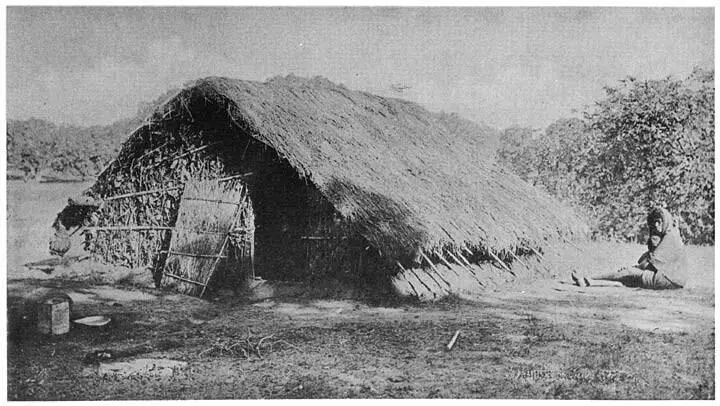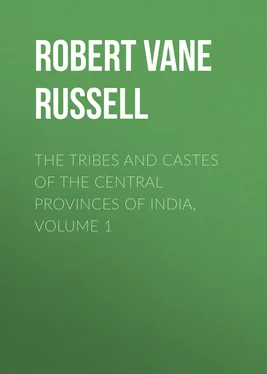Robert Vane Russell - The Tribes and Castes of the Central Provinces of India, Volume 1
Здесь есть возможность читать онлайн «Robert Vane Russell - The Tribes and Castes of the Central Provinces of India, Volume 1» — ознакомительный отрывок электронной книги совершенно бесплатно, а после прочтения отрывка купить полную версию. В некоторых случаях можно слушать аудио, скачать через торрент в формате fb2 и присутствует краткое содержание. Жанр: foreign_prose, История, foreign_edu, foreign_antique, на английском языке. Описание произведения, (предисловие) а так же отзывы посетителей доступны на портале библиотеки ЛибКат.
- Название:The Tribes and Castes of the Central Provinces of India, Volume 1
- Автор:
- Жанр:
- Год:неизвестен
- ISBN:нет данных
- Рейтинг книги:5 / 5. Голосов: 1
-
Избранное:Добавить в избранное
- Отзывы:
-
Ваша оценка:
- 100
- 1
- 2
- 3
- 4
- 5
The Tribes and Castes of the Central Provinces of India, Volume 1: краткое содержание, описание и аннотация
Предлагаем к чтению аннотацию, описание, краткое содержание или предисловие (зависит от того, что написал сам автор книги «The Tribes and Castes of the Central Provinces of India, Volume 1»). Если вы не нашли необходимую информацию о книге — напишите в комментариях, мы постараемся отыскать её.
The Tribes and Castes of the Central Provinces of India, Volume 1 — читать онлайн ознакомительный отрывок
Ниже представлен текст книги, разбитый по страницам. Система сохранения места последней прочитанной страницы, позволяет с удобством читать онлайн бесплатно книгу «The Tribes and Castes of the Central Provinces of India, Volume 1», без необходимости каждый раз заново искать на чём Вы остановились. Поставьте закладку, и сможете в любой момент перейти на страницу, на которой закончили чтение.
Интервал:
Закладка:

Peasant’s hut
Several Rājput clans, as the Panwārs of the Wainganga Valley, the Rāghuvansis, the Jādums derived from the Yādava clan, and the Daharias of Chhattīsgarh, have formed distinct castes, marrying among themselves. A proper Rājpūt should not marry in his own clan. These groups have probably in the past taken wives from the surrounding population, and they can no longer be held to belong to the Rājpūt caste proper, but rank as ordinary agricultural castes. Other agricultural castes have probably been formed through mixed descent from Rājpūts and the indigenous races. The Agharias of Sambalpur say they are sprung from a clan of Rājpūts near Agra, who refused to bend their heads before the king of Delhi. He summoned all the Agharias to appear before him, and fixed a sword across the door at the height of a man’s neck. As the Agharias would not bend their heads they were as a natural consequence all decapitated as they passed through the door. Only one escaped, who had bribed a Chamār to go instead of him. He and his village fled from Agra and came to Chhattīsgarh, where they founded the Agharia caste. And, in memory of this, when an Agharia makes a libation to his ancestors, he first pours a little water on the ground in honour of the dead Chamār. Such stories may be purely imaginary, or may contain some substratum of truth, as that the ancestors of the caste were Rājpūts, who took wives from Chamārs and other low castes. The Kīrārs are another caste with more or less mixed descent from Rājpūts. They are also called Dhākar, and this means one of illegitimate birth. The Bhilālas are a caste formed of the offspring of mixed alliances between Rājpūts and Bhīls. In many cases in Nimār Rājpūt immigrants appear to have married the daughters of Bhīl chieftains and landholders, and succeeded to their estates. Thus the Bhilālas include a number of landed proprietors, and the caste ranks as a good agricultural caste, from whom Brāhmans will take water. Among the other indigenous tribes, several of which have in the Central Provinces retained the possession of large areas of land and great estates in the wilder forest tracts, a subcaste has been formed of the landholding members of the tribe. Such are the Rāj-Gonds among the Gonds, the Binjhāls among Baigas, and the Tawar subtribe of the Kawar tribe of Bilāspur, to which all the zamīndārs 50 50 Proprietors of large landed estates.
belong. These last now claim to be Tomara Rājpūts, on the basis of the similarity of the name. These groups rank with the good agricultural castes, and Brāhmans sometimes consent to take water from them. The Dāngis of Saugor appear to be the descendants of a set of freebooters in the Vindhyan hills, much like the Gūjars in northern India. The legend of their origin is given in Sir B. Robertson’s Census Report of 1891: “The chief of Garhpahra or old Saugor detained the palanquins of twenty-two married women and kept them as his wives. The issue of the illicit intercourse were named Dāngis, and there are thus twenty-two subdivisions of these people. There are also three other subdivisions who claim descent from pure Rājpūts, and who will take daughters in marriage from the remaining twenty-two, but will not give their daughters to them.” Thus the Dāngis appear to have been a mixed group, recruiting their band from all classes of the population, with some Rajpūts as leaders. The name probably means hillman, from dāng , a hill. Khet men bāmi, gaon men Dāngi or ‘A Dāngi in the village is like the hole of a snake in one’s field,’ is a proverb showing the estimation in which they were formerly held. They obtained estates in Saugor and a Dāngi dynasty formerly governed part of the District, and they are now highly respectable cultivators. The Mīnas or Deswālis belonged to the predatory Mīna tribe of Rājputāna, but a section of them have obtained possession of the land in Hoshangābād and rank as a good agricultural caste. The Lodhas of the United Provinces are placed lowest among the agricultural castes by Mr. Nesfield, who describes them as little better than a forest tribe. The name is perhaps derived from the bark of the lodh tree, which was collected by the Lodhas of northern India and sold for use as a dyeing agent. In the Central Provinces the name has been changed to Lodhi, and they are said to have been brought into the District by a Rāja of the Gond-Rājpūt dynasty of Mandla in the seventeenth century, and given large grants of waste land in the interior in order that they might clear it of forest. They have thus become landholders, and rank with the higher agricultural castes. They are addressed as Thākur, a title applied to Rājpūts, and Lodhi landowners usually wear the sacred thread.
21. Status of the cultivator
The above details have been given to show how the different agricultural castes originated. Though their origin is so diverse they have, to a great extent, the same status, and it seems clear that this status is dependent on their possession of the land. In the tracts where they reside they are commonly village proprietors and superior tenants. Those who rank a little higher than the others, as the Jāts, Marāthas, Dāngis and Lodhis, include in their body some ruling chiefs or large landed proprietors, and as a rule were formerly dominant in the territory in which they are found. In primitive agricultural communities the land is the principal, if not almost the sole, source of wealth. Trade in the modern sense scarcely exists, and what interchange of commodities there is affects, as a rule, only a trifling fraction of the population. India’s foreign trade is mainly the growth of the last century, and the great bulk of the exports are of agricultural produce, yet in proportion to the population the trading community is still extremely small. It thus seems quite impossible that the Aryans could have been a community of priests, rulers and traders, because such a community would not have had means of subsistence. And if the whole production and control of the wealth and food of the community had been in the hands of the Sūdras, they could not have been kept permanently in their subject, degraded position. The flocks and herds and the land, which constituted the wealth of early India, must thus have been in the possession of the Vaishyas; and grounds of general probability, as well as the direct evidence already produced, make it clear that they were the herdsmen and cultivators, and the Sūdras the labourers. The status of the modern cultivators seems to correspond to that of the Vaishyas, that is, of the main body of the Aryan people, who were pure and permitted to join in sacrifices. The status, however, no longer attaches to origin, but to the possession of the land; it is that of a constituent member of the village community, corresponding to a citizen of the city states of Greece and Italy. The original Vaishyas have long disappeared; the Brāhmans themselves say that there are no Kshatriyas and no Vaishyas left, and this seems to be quite correct. But the modern good cultivating castes retain the status of the Vaishyas as the Rājpūts retain that of the Kshatriyas. The case of the Jāts and Gūjars supports this view. These two castes are almost certainly derived from Scythian nomad tribes, who entered India long after the Vedic Aryans. And there is good reason to suppose that a substantial proportion, if not the majority, of the existing Rājpūt clans were the leaders or aristocracy of the Jāts and Gūjars. Thus it is found that in the case of these later tribes the main body were shepherds and cultivators, and their descendants have the status of good cultivating castes at present, while the leaders became the Rājpūts, who have the status of the Kshatriyas; and it therefore seems a reasonable inference that the same had previously been the case with the Aryans themselves. It has been seen that the word Visha or Vaishya signified one of the people or a householder. The name Kunbi appears to have the same sense, its older form being kutumbika , which is a householder or one who has a family, 51 51 See article on Kunbi, para. 1.
a pater familias .
Интервал:
Закладка:
Похожие книги на «The Tribes and Castes of the Central Provinces of India, Volume 1»
Представляем Вашему вниманию похожие книги на «The Tribes and Castes of the Central Provinces of India, Volume 1» списком для выбора. Мы отобрали схожую по названию и смыслу литературу в надежде предоставить читателям больше вариантов отыскать новые, интересные, ещё непрочитанные произведения.
Обсуждение, отзывы о книге «The Tribes and Castes of the Central Provinces of India, Volume 1» и просто собственные мнения читателей. Оставьте ваши комментарии, напишите, что Вы думаете о произведении, его смысле или главных героях. Укажите что конкретно понравилось, а что нет, и почему Вы так считаете.












